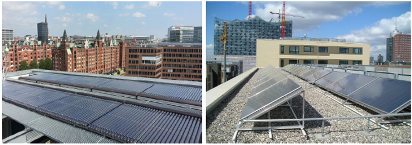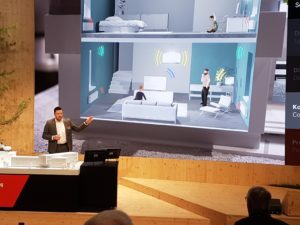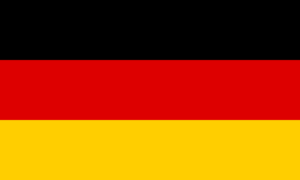Germany: Hamburg’s Eight-Year Large-Scale Solar Thermal Monitoring
November 4, 2014
 Since 2006, the Solarzentrum Hamburg (translated as Solar Centre Hamburg) has been in charge of monitoring the city’s large-scale solar thermal plants. In 2013, this monitoring programme covered 77 plants with a total aperture area of 6,612 m². In December 2015, Solarzentrum Hamburg’s centralised control will end, after monitoring the last batch of systems which started their two years in the programme by the end of 2013. The two attached presentations in German summarise the 2012 and 2013 monitoring results.
Since 2006, the Solarzentrum Hamburg (translated as Solar Centre Hamburg) has been in charge of monitoring the city’s large-scale solar thermal plants. In 2013, this monitoring programme covered 77 plants with a total aperture area of 6,612 m². In December 2015, Solarzentrum Hamburg’s centralised control will end, after monitoring the last batch of systems which started their two years in the programme by the end of 2013. The two attached presentations in German summarise the 2012 and 2013 monitoring results.Photos: Solarzentrum Hamburg
The idea of the monitoring is to support solar-generated energy, not installed collector area: If incentives are paid for installed collector area, the control ends as soon as an installation is finished. “But at the time the system comes into operation, there is still a lot of work to be done,” Dolores Lange, the person responsible for evaluations at Solarzentrum Hamburg, points out. Until the plant can achieve optimal performance, pump settings and control functions require a lot of adjustment.
Companies which participate in the monitoring programme guarantee their customers a solar yield of 350 kWh/m²*year for solar water heating and 300 kWh/m²*year for plants which include solar space heating. If the plants fail to deliver this yield, a penalty of 0.20/EUR/kWh of missing solar yield will have to be paid. “This happened only once in the history of the programme,” Lange says. Usually, customers and installers come together to seek a solution in such a situation.
Monitoring prevents plant downtimes
It is often forgotten that a solar thermal plant needs some regular inspection and maintenance, just like any other technical installation. “When it comes to large-scale plants, one inspection a year is not enough,” Lange says. As part of the monitoring programme, Solarzentrum Hamburg checks the solar yield and hot water consumption of all plants on a monthly basis in order to quickly detect any basic issues with the system – for example, if an over-heated safety valve opened and caused the system to stop working. Without any monitoring, simple-to-fix errors like this may remain undetected for years. Theoretically, maintenance could be done by the plant owners. “Reality, however, shows that really only a few plant owners have the know-how and time to look after their solar thermal plants,” Lange explains.
Key factors: good planning, experience, simple hydraulics
Statistics show that two-thirds of the plants monitored in 2013 were built by three companies: Atherm, ad fontes and Microsol. While Atherm is a new entrant into the market, Microsol and ad fontes have already been major players in Hamburg’s large-scale plant market in Hamburg for years. All other companies had between one and three of their plants monitored in 2013, but some of them had been very active in previous years. According to Lange, some companies manage to gain solar yields significantly above average. The key factors for those companies are their experience and their motivation regarding after-sales plant enhancement, she says.
Especially everything related to hydraulics is a challenge for many planners and installers. What causes the most problems during the planning process is a pump or expansion vessels that is too small for the system. Several times, the monitoring programme recorded smaller yields because the plant was designed with a minimum collector area in order to meet solar building codes – although technical difficulties could have been foreseeable: Collector fields on different parts of the roof that have different heights easily lead to problems with the hydraulics. A collector field that is too big for the actual hot water requirements or a small, confined storage tank is going to reduce the specific solar yield dramatically.
Great progress in online monitoring software
Lange says that the software solutions which are used for monitoring the systems have changed and improved a lot over time. The plant operators can choose among a variety of control software programs. In the early years, data transfer was based on modems. Often, data was not sent completely. Today, there are more web-based monitoring tools, mostly offered by German component manufacturers, such as Resol, Weishaupt or Paradigma. They connect to a building’s Wi-Fi network or come with their own internet access. Communication has become a lot more reliable between 2012 and 2013, Lange adds. In 2013, the most frequently used tool was still Microsol Data Collect, a software program from Hamburg-based engineering company Microsol. Each month, it sends the data automatically via email.
Of the plants monitored in 2013, 64 % had been installed on blocks of flats and 36 % on other buildings (including 22 mosques). Until the end of 2013, the city of Hamburg had paid an extra incentive of 60 EUR/m² of aperture area for all plants larger than 30 m² if they had been part of the monitoring programme. The incentive was paid directly to the installation company, which was responsible for carrying out monitoring in cooperation with the Solarzentrum. The plants were monitored for a minimum of two years. At the beginning of 2014, Hamburg changed the rules of the programme. Now, it is not the installation company, but also the customer who has to apply for the monitoring incentive. The new incentive is EUR 1,750 for systems of between 20 and 100 m² of aperture area, EUR 2,600 for installations of between 100 and 200 m² of aperture area and an individually set amount for systems with more than 100 m².
More information:
http://www.solarzentrum-hamburg.de/ (German only)
Current Solar Thermal Incentives in Hamburg:


